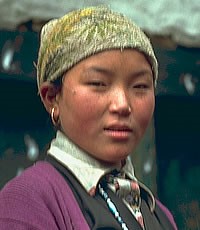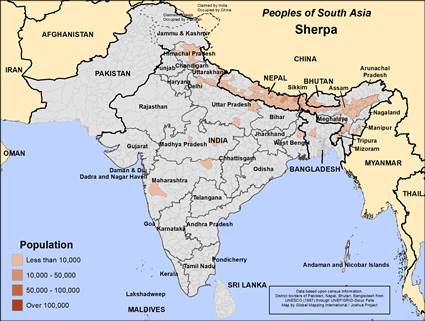The name Sherpa is derived from the Tibetan word sharpa, meaning "people from the East." A sub-group of the Bhotia, the Sherpas are a Tibetan-related ethnic group.
Many live in the Solukhumbu Valley, especially Pangboche village. This is the gateway to Mt. Everest, so they are in a good position to earn a living by helping wealthy foreigners with mountain treks and hospitality needs. In 1953, they gained worldwide attention (as well as a tourist industry) when a Sherpa climber named Tenzing Norgay accompanied Sir Edmund Hillary to the summit of Mount Everest.
Along with their homeland, several thousand live in Nepal's capital city of Kathmandu, in the Indian city of Darjeeling, and in Indian hill towns. Smaller numbers are in China and Bhutan. There is also a Sherpa diaspora in the United States.
The Sherpa language is a dialect of Tibetan and is part of the family of languages to which many other Nepali languages belong. All Sherpa speak Nepali, the official language of Nepal. While Sherpa is not a written language, many Sherpa are literate in Tibetan, Nepali, and occasionally, Hindu and English.
Sherpa villages range anywhere from a few households to more than one hundred houses. A Sherpa family unit consists of the nuclear family living in a single household and sharing a joint economy. Houses are at least two stories, the upper story being a one-room living quarter and the lower story serving as an animal shed and storage area.
When the youngest son marries, he inherits the farmhouse and half of the fields. He also must take care of his parents. The older sons receive the remaining fields as their inheritance. A middle son will often bring honor to his family by attending a monastery in order to become a lama, or holy man.
In the past, marriages have always been arranged by the family. This tradition seems to be changing with the increase of Western influence. Also, divorce is frequent, occurring in an estimated one-third of Sherpa marriages.
There are few government schools in the Solu-Khumbu region, making it necessary for children to walk long distances to school. For this reason, children do not attend school regularly, although the government requires three years of education. It may take a child six years to complete this requirement. The lack of education among the Sherpa has resulted in a literacy rate of only less than one-third.
Trading is an important economic activity for the Sherpa. The men make long trading expeditions and are often gone for many months, leaving the remaining duties to the women. The Sherpa often act as middlemen between Tibetan traders and those from the lower-lying regions of Nepal. Working as middlemen has enabled the Sherpa to attain higher standards of living than those of other hill people.
Tourism provides the Sherpa with alternative activities and sources of income. The people use their homes as overnight shelters for mountain-climbing expeditions, and they also work as cooks, porters and guides. They earn a good living from their wealthy, adventurous clients. However, the job of leading mountain treks is very dangerous. Tourist-related jobs are becoming more and more prevalent in the Sherpa economy.
Religion has a very strong hold on the Sherpa. The Sherpa generally follow the Tibetan form of Buddhism combined with animism (the belief that non-human objects have spirits). Tibetan Buddhism is intertwined with bon, a form of shamanism. These beliefs encompass everything the Sherpa do. They follow folk beliefs and perceive spirits everywhere. The Sherpa celebrate many festivals that involve a combination of religion and magic.
Sherpas believe the mountains are the home of the gods. For that reason, they believe the mountains need to be honored, not “conquered” by tourists. They draw the line when foreign trekkers want to burn garbage or little the beautiful mountains.
Since the 1980s there have been a number of Sherpas in Nepal and India who have accepted the lordship of Christ. That is not the case in Bhutan or China.
Pray that God will give Sherpa believers boldness to share the love of Christ, winning many to the Throne of Grace in Nepal and Bhutan.
Ask the Lord to send forth laborers into Nepal to minister to the needs of the Sherpa.
Pray that many audio Christian materials will be translated into the Sherpa language.
Ask the Lord to bring forth a strong, multiplying Sherpa church that will bless their entire community.
Scripture Prayers for the Sherpa in Nepal.
https://en.wikipedia.org/wiki/Sherpa_people
https://www.cnn.com/travel/article/sherpa-facts/index.html
https://www.britannica.com/topic/Sherpa-people
| Profile Source: Joshua Project |













